Assembly
The encampment will form up entirely in column formation, with the commanders in column formation as well. Once the command is given by the cadet commander to march forward, the flight commanders will echo the command and march forward. Any column movements needed to manuver the flights onto the ready line are given by the individual flight commanders. The formation would appear as below, without the squadron commanders:
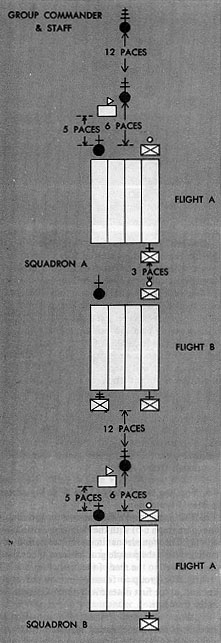
The encampment marches on to the parade field from the left-hand side of the diagram below (figure 7-1, AFM 36-2203):
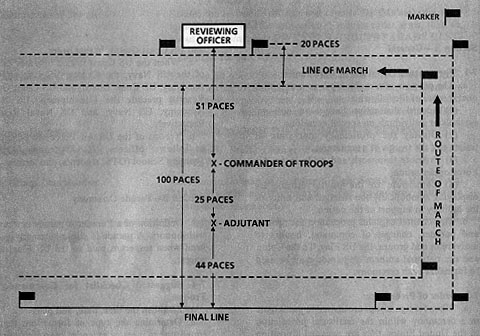
Music: Washington Post March, Americans We, Bravura, or any other music in the "A - Marches For Gathering" section of the ACC music list. Select enough music (or play one song multiple times) to allow enough time for the parade to march into position.
Once the encampment reaches the first marker in the lower left corner of the diagram, the cadet commander and the deputy cadet commander will "peel off" to head towards the center. The diagram below marks the path which the command staff takes, from spot #1.
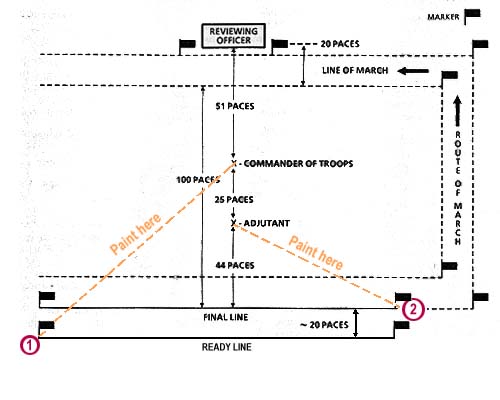
The adjutant, when reaching spot #1 (who will march with the cadet commander until this point) breaks off, and marches down the final line, and then stops at spot #2 above. It is vitally important that the adjutant be on the final line, whereas the rest of the troops will be on the ready line.
Once all the troops are in position on the ready line, in line (see below diagram) formation, the pass in review is ready to move onto the next portion. This is the point when the march-on music ceases.
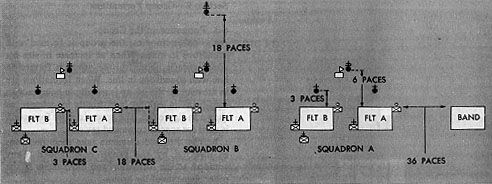
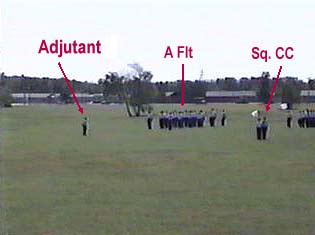
The Adjutant on the final line, the troops on the ready line
March On
| Adjutant | Commands SOUND ADJUTANT'S CALL (click here for inflection sample). Music: Adjutant's Call |
| Cadet Commander | On the first note of Adjutant's call, come to attention, execute an about face (staff does not turn around- i.e. no change post), and call the flights to attention. Music: march on music used above, such as Washington Post March... the National Emblem works particularly well here. Then, |
| Flight Guidon Bearers | On the command, GUIDES ON LINE, the guidon bearers double-time (yes, double-time in blues, it's OK) to their spots on the final line. Once they reach their spot, they immediately do a right face. All flight guidon bearers should perform this movement in unison, and face in unison. |
| Cadet Commander | Next, command Forward, MARCH |
| Cadet Commander | Command P-a-rade, (flight commanders echo "P-a-rade") REST. |
| Adjutant | Commands SOUND OFF (if you have a band) or In Place, SOUND OFF |
Formation of Parade
| Adjutant | Commands GIVE YOUR FLIGHTS PRESENT ARMS. |
| Flight Commanders | Command Present, ARMS. |
| Adjutant | Faces about, salutes, and reports Sir (Ma'am), the parade is formed. |
| Cadet Commander | Returns the salute and commands TAKE YOUR POST. |
| Adjutant | Moves directly toward the commander of troops (cadet commander), executes a 45-degree pivot while marching to the left, then executes a 45-degree pivot while marching to the right, halts in position 1 and 1/2 paces behind and one pace to the commander's right, and executes about face |
| Cadet Commander | Commands GIVE YOUR FLIGHTS ORDER ARMS. |
| Flight Commanders | Command Order, ARMS. |
| Cadet Commander | Commands to the adjutant, but audibly, RECEIVE THE REPORT. |
| Adjutant | Marches straight toward the troops until beside the cadet commander, executes a 45-degree pivot while marching to the left, then executes a 45-degree pivot while marching to the right, then marches back to the adjutant's spot (25 paces away from Cadet Commander), and commands REPORT. |
| Flight Commanders | From adjutant's left to right, report while saluting A (B, C) Flight, all present or accounted for, Sir (Ma'am). |
| Adjutant | Returns salute of each group commander individually, one at a time, executes about face, salutes, and reports Sir (Ma'am), all present or accounted for. |
| Cadet Commander | Returns the salute and commands PUBLISH THE ORDERS. |
Officer's Center
| Adjutant | Faces about and commands ATTENTION TO ORDERS, Detail for today, *______ (Lt, MSgt) ________, by order of (by command of.. if Rank of encampment commander is a General) Colonel (or rank of encampment commander) _________ (insert name of encampment commander), C. A. P. (* - use local detail titles, otherwise just say "detail for today" - potential "details" could be Cadet officer of the Day, final flight with KP duty, etc.) |
||||||||||||||||
| Adjutant | Once finished publishing the orders, command OFFICERS | ||||||||||||||||
| Commanders + Guidon bearers: | At the command OFFICERS, the following personnel will take the # steps perscribed below. The steps for the flight commanders were modified from AFM 36-2203 to create only two rows of commanders, not three. If the encampment has 12 (or more) flights, use three rows (where the third flight from right to left takes 2 steps forward).

|
||||||||||||||||
| Adjutant | Once the commanders and guidon bearers halt after stepping forward,command CENTER | ||||||||||||||||
| Commanders + Guidon Bearers | Of those described above as taking steps (0 or otherwise), face the center of the formation. | ||||||||||||||||
| Adjutant | Once the commanders and guidon bearers face center,command MARCH. Music that starts with this command: Officer's Center March (the proper choice), or National Emblem (if you can't get Officer's Center March). It is played until officers are in position in front of Cadet commander |
||||||||||||||||
| Commanders + Guidon bearers: | On the command MARCH, the officers and guidon bearers march toward the center of the formation, maintaining relative positions. Upon reaching the center, each individual halts and automatically faces the front at close interval. The group commander and their staffs close to the center, maintaining relative unit positions (see image above) THE OFFICER'S FORMATION IS NOT CUSTOMIZABLE- it is a boring box, there is no justification for modifying this formation to a shape other than rectangular/square. The guidon bearers are directly behind their commander. While marching, they slowly increase their distance to allow room for their guidon poles at present arms. When officers and guidons have reached the center and faced to the front, the right and left flank commanders (A Flight Commander (on the right flank), and the last Flight Commander (on the left flank)), addressing the senior ranking cadet among the officers, say Sir (Ma'am), all in from the right (left). The senior officer then commands Forward, MARCH. The center officer in each rank is the base element, and the senior officer commands Officers, HALT. * - Note: this section is briefly described in the drill manual. This is a detailed breakdown. The Officers, HALT command is done in a total of eight counts:
A good way for the group to remember is once the command HALT is given, have them use the pneumonic "Step, Stop, Pop" (as in step, halting, and "poping" a salute). |
||||||||||||||||
| Cadet Commander | The Cadet Commander returns the salute and commands Order, ARMS to end the salute and return guidon bearers to carry guidon. | ||||||||||||||||
| Cadet Commander | If a unit award (streamer) is to be presented, such as honor or warrior flight/squadron, the cadet commander commands the appropriate unit guidon Front and Center, MARCH. On the command Center, the designated guidon bearer takes one step to the rear and faces to the nearest flank. On the command MARCH, a route is taken around the nearest flank to a position four paces in front of the cadet commander. The bearer then executes the individual salute with the guidon so it is in a convenient position for the streamer to be attached. The Cadet Commander then affixes the streamer onto the guidon (who is at present arms). The guidon bearer returns to the carry position and executes the infividual guidon salute. The cadet commander commands Post and then MARCH. The guidon bearer returns to the normal position by the same route he or she took when moving to the front. | ||||||||||||||||
| Cadet Commander | The Cadet Commander commands Officers, Post, MARCH. | ||||||||||||||||
| Commanders + Guidon Bearers + First Sergeants | On the command Post, officers, guidon bearers, On the command MARCH, they step off. Music: Same as officer's center march, above. Music starts at the command MARCH. (first sergeants return to their position within the mass, reversing the route they used to take command in the squadron commanders' absence.) |
||||||||||||||||
| Senior Flight Commander | The senior flight commander commands Officers, HALT when the leading rank is approximately four paces from the final line. The senior flight commander waits three counts in between Officers and HALT (e.g., "officers", step, step, step, "HALT"). Then the command Post, MARCH is given. | ||||||||||||||||
| Commanders + Guidon Bearers | On the command Post, officers and guidon bearers face outward toward their respective group. On the command MARCH, officers and guidon bearers move off in succession at four pace distances. Thus, the officers and guidon bearers nearest the flanks of the officer formation step off on count one, and the next ones step off on count five, etc. Flight commanders and guidon bearers execute right (left) flank (so they end up facing their units) upon arriving at their respective units and halt in their original positions in the formation. All face about at Adjutant's command Post. Guidon bearers return to order guidon. Music: At the conclusion of these movements, the music stops playing. |
Presentation of Command
| Cadet Commander | Commands GIVE YOUR FLIGHTS PRESENT ARMS. |
| Flight Commanders | Command Present, ARMS. |
| Cadet Commander | Commands quietly to the Adjutant and C/DCC Staff, Change Post, MARCH (may salute automatically after posting). Commands Staff, Present, ARMS. Reports to reviewing officer (usually encampment commander, may be installation commader or similar) (audibly) Sir (Ma'am), I present the command. Music: Ruffles and Flourishes and the appropriate march are played, if the grade or title of the reviewing officer warrants it. General officers (or Admirals) receive one ruffle and flourish for each star of their rank. |
| Reviewing Officer | Returns the salute, and then, adapting the words to the occasion, Have the person(s) to be retired (decorated, receive awards, etc.) and the Colors come forward. (Note: for encampments, it is common that the encampment awards are given as a surprise. Since this is the case, the reviewing officer will normally say "Have the Colors come forward". With the colors present, the encampment awards are then given.) |
| Cadet Commander | Commands Staff, Order, ARMS. and GIVE YOUR FLIGHTS ORDER ARMS. |
| Flight Commanders | Command Order, ARMS. |
| Cadet Commander | Commands Colors, CENTER, MARCH. (since this command is given with a group of people who already know they are being awarded an award, generally at encampment nothing happens as a result of this command, other than the cadet commander marching down the center of the formation to the Color Guard. If the encampment does want members to come front and center at this point, these members would march out into the center of the formation, behind the color guard, and fall into a flight per this command). Also, as the Cadet Commander starts marching, it is customary for the Adjutant and C/DCC to face away from the center of the formation, march 6 paces, halt and about face- this is to make room for the Color Guard. Music: National Emblem (required -can be whole song or trio section). Starts when cadet commander commands MARCH, and ends when detachment returns to the front of the formation. Marches forward, halts six paces from the front rank of the detachment, faces about and commands Detachment, Forward, MARCH (or while marching, commands Detachment, Forward, March), ensuring individuals remain in step with music. Commands Detachment, HALT when the Color Guard + others are about 12 paces from the reviewing stand. Once individuals are in place, salutes and reports Sir (Ma'am), the person(s) to be retired (decorated, receive awards, etc.) and the Colors are present. |
| Reviewing Officer | Returns the salute, and directs PRESENT THE COMMAND. |
| Cadet Commander | Returns to position and commands GIVE YOUR FLIGHTS PRESENT ARMS. |
| Group Commanders | Command Present, ARMS. |
| Cadet Commander | Faces about and commands Staff, Present, ARMS Music: Star Spangled Banner or To The Colors are played here. |
| Cadet Commander | After last note of music, commands Staff, Order, ARMS and GIVE YOUR FLIGHTS ORDER ARMS. |
| Flight Commanders | Command Order, ARMS. |
| Cadet Commander | Commands GIVE YOUR FLIGHTS PARADE REST. |
| Group Commanders | Command Parade, REST. |
| Cadet Commander | Faces about and commands Staff, Parade, REST. |
| Reviewing officer | Makes presentations for encampment awards, such as honor flight, most improved cadet, honor cadet, etc., as well as any other awards such as commander's commendations, etc. |
| Color Guard | Following presentations, executes a right about and returns to its original position on the final line. |
| Cadet Commander | As the Colors are approximately six paces in front of where the cadet commander normally stands, command Staff, ATTENTION. As the Colors are abreast of the cadet commander's position, faces about. As the Colors approach the final line, commands GIVE YOUR FLIGHTS ATTENTION. |
| Flight Commanders | Command Flight, ATTENTION. |
| Adjutant + C/DCC | After the Cadet Commander faces about when the Color Guard passes, the Adjutant and the Cadet Deputy Cadet Commander march back toward the center, resuming their position as a staff of the cadet commander. |
| Cadet Commander | When the colors are in position, faces about and salutes the reviewing officer, but gives no report. |
| Reviewing officer | Returns the salute and commands MARCH THE COMMAND IN REVIEW. |
| Cadet Commander | Returns to order arms, and commands Staff, Change Post, MARCH (see para 7.18.4 of AFMAN 36-2203 for instructions) and PASS IN REVIEW (click here for a sample of the proper inflection). |
| Flight Commanders | Command Flight, Right, FACE. Once the flight commanders and guidon bearers are in position for column formation, command Forward, MARCH. (since units are not in mass formation, the column of flights command is not used here). These commands are called from the rightmost flight to the leftmost flight. The second flight does not start until after the first flight calls the command. |
| Color Guard | Perform a half-right wheel or about as soon as the first flight turns. Call Forward, MARCH as soon as the adjacent flight starts marching. |
Pass In Review
| Flight/CC + Guidon Bearers | On the command Right, FACE, the guidon bearer and the flight commander position themselves in column formation, like in the picture below.
 Group, Squadrons and Flights in Column formation (note position of guidon bearers and flight commanders)
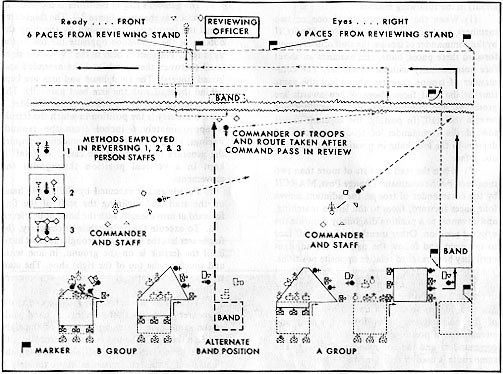 Music: Any marching music, listed in sections A or I on the list (march on or departing music), is appropriate for the pass in review. The music starts as soon as the command MARCH is given by the first group commander. While marching the pass in review, the flights perform column lefts to follow the pass in review route. When the flight is about 10 paces from the review stand, the flight commander commands Eyes.... RIGHT. The command is given on four counts, on the right foot:
Once the review stand is passed, at the second marker 6 paces after, the commander calls Ready, FRONT, in reverse fashion from above (called on the left foot) |
||||||||||
| Cadet Commanders | The commander performs a column left on their own command when reaching a turn in the marching route. When the cadet commander and staff approachs the reviewing stand, he or she commands eyes right, and the staff members perform eyes right as a flight would (i.e. the rightmost staff member does not turn their head), and the commander performs a salute while at eyes right. | ||||||||||
| Once all of the troops have passed the review stand, they march off to the designated area.. |
 Continuusly under construction- last updated 12 JUN 2001.
Continuusly under construction- last updated 12 JUN 2001.